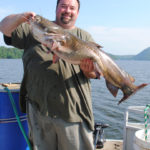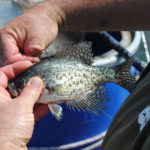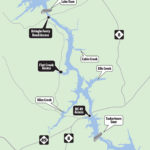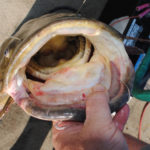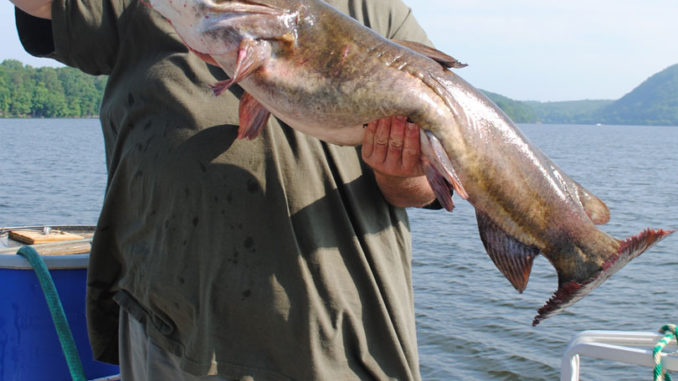
Stick to the main river channel and fish on the bottom for Tuckertown flatheads.
For years, a trip to Tuckertown Lake was a busman’s holiday for Stanley Correll. Now it’s just pure pleasure.
For a decade or so, Correll guided fishermen on Lake James, Lake Hickory and Lake Rhodhiss for striped bass, smallmouth bass and walleye, but when he wanted to fish for fun, he packed up the pontoon boat and headed somewhere to catch big whiskered fish.
Back before the turn of the century, Correll made his first trip to Tuckertown Lake, drawn by stories about the narrow, little Yadkin River system reservoir being North Carolina’s No. 1 hot spot for flathead catfish. That first trip was all it took.
“The first flathead I caught here was a 58-pounder,” said Correll, who has returned to North Carolina after a handful of years working at the Bass Pro Shops in Fort Myers, Fla. “I had four that day that weighed 171 pounds total. I went crazy. I’d never caught fish like that before.”
Now living in Lenior, Correll hasn’t forgotten how to catch the big, yellow catfish at Tuckertown. No longer guiding, fishing is all fun now, especially when he drags his pontoon down US 70 to the 2,560-acre reservoir that’s tucked in between High Rock Lake upstream and Badin Lake downstream.
And nothing has happened to change his mind that Tuckertown is the flathead place to be. The reason, he said, is that the lake has a handful of “textbook” places to find flatheads, and because of its relative small size, he can fish most of them in a day’s time if he has to.
“You want places where there’s shallow water next to deep water, with a bunch of food,” he said. “One reason I like this lake better than High Rock or Badin is that because there are fewer textbook places, they’re easier to find.
“Most of my best places on Tuckertown are associated with a channel drop, in a place where there’s an intersection between a creek channel and the main-river channel,” he said. “And most of the river-channel edges have hard bottoms — lots of boulders.”
But Correll doesn’t fish those drops. He fishes the actually river channel, setting up and anchoring out of both ends of his boat over water that can be anywhere from 25 to 50 feet deep, depending on the part of the lake he’s targeting. He puts out a half-dozen or so rods with live baits of various sizes and species, keeping some of them on the bottom and suspending some a few feet above it, and he waits for things to start happening.
And looking at the calendar, Correll said things are about to start happening. There’s no season better than the three or so months that bridge from late summer to Thanksgiving for catching flatheads at Tuckertown. The action usually picks up in August, and as the water cools into September and October, fish have no qualms with picking up a live crappie or bream and trying to pull the fishermen who’s holding the other end of the line over the gunwales, into the lake with them.
“The optimal water temperature for flatheads is anywhere from 65 to 80 degrees, and you can catch them, relatively easily, any time from late summer through fall,” he said. “My preferred months are September, October and November. I think they group up in the fall; the rest of the year, flatheads are more solitary.”
Anyone who has dealt with one of the ill-tempered, yellow-brown catfish with the shovel-like heads and the little beady eyes will understand why they might be solitary. With a bad attitude that would make a career criminal blanch, a flathead probably doesn’t care for much finny company, unless it’s the kind he’s planning on having for dinner, ala Hannibal Lechter.
Correll has some distinct preferences in the kind of dinner he offers Tuckertown’s flatheads, and unfortunately, some changes the lake has undergone in recent years — plus some changes in creel limits and size minimums put in place by the N.C. Wildlife Resources Commission — has affected how he collects them.
Normally, Correll would show up a few hours before he planned to be on the water targeting catfish, and he’d hit a handful of brush piles, tree laps and bridge pilings with an ultralight spinning outfit and mini jigs and put several dozen live crappie in his bait tank. Two things have made that more difficult: the Commission instituted an 8-inch size minimum for Tuckertown crappie several years ago, and the lake has been infested with black mat algae around shorelines, making it tougher to catch crappie in the shallows.
“One thing that makes Tuckertown such a great place for flatheads is that the lake is just full of stunted crappie; 95 percent of them are 5 to 7 inches long. There are a millions of them for the flatheads to eat. But you go out and catch 75, and you might have five or six keepers.
“Bluegills make fine live baits, and when I first started to fish (Tuckertown), I didn’t know the lake and where the brush piles were, so I just caught bluegills,” Correll said. “But I think you get more bites on live crappie.
“When I came back from Florida last year and the black mat algae was all over the lake, that made it harder to catch crappie, so I’ve had to use more shad, and I’ve started to catch more channel cats and blues — but that’s not what I come for.”
So more shad and bluegills are making their way into his bait tank, but the places he fishes and how he fishes haven’t changed.
Correll likes to fish on the bottom in the main-river channel, close to the mouth of a tributary creek. He will cruise over the river-channel ledge, looking for baitfish and gamefish to mark on his depth finder, and when he’s over the channel proper, he’ll look for the marks and little inconsistent spots on the bottom that mark great places for catfish to hide.
“There are big rocks all over the bottom of the river channel — all the mud has been washed away — and those flatheads will lay up behind the rocks,” he said. “Normally, you’d think fish would be on the edge of the channel, either at the top or bottom of the ledge, but I’ve found over the years that the flatheads will get out in the middle of the channel. There doesn’t have to be an edge. They’ll move up and down the channel.
“This is a lake where you can actually come out and anchor down in the middle of the channel, and if you have current, you have a change to catch a flathead.”
Ah, current. The company that manages the hydroelectric plants on the Yadkin River, Yadkin Inc. (a division of Alcoa), make power by pulling water downstream through the dams, spinning the turbines and supplying what’s needed to run hundreds of thousands of air conditioners in the Piedmont. But Yadkin Inc. has never been particularly fishermen-friendly. It doesn’t publish a generation scheduled, and requests for information on when power might be generated through High Rock, Tuckertown or Narrows (Badin) dams rarely draw any kind of answer. So the fisherman is gambling, to a certain extent, that he’ll be on the lake when water is pulled through the dams either upstream or downstream from him.
When it is, there’s current in the lake, a stream of moving water that pushes food ahead of it and wakes up the predatorial nature of catfish, stripers, largemouth bass, crappie — you name it. At Tuckertown, it’s like ringing the dinner bell.
“They are conditioned to feed if there’s current present,” Correll said. “I find that these fish move around more than any flatheads I’ve ever seen. When the current is running, they’ll come out and move around and feed.”
As such, Correll said being “mobile” is important. He doesn’t mean picking up and running all over the lake; he can fish a half-dozen spots without moving more than a quarter of a mile, and because of the way he anchors his boat, he can often effectively change spots without even pulling up his anchors.
Correll keeps anchors with around 250 feet of line in a 10-gallon bucket in the bow and stern of his pontoon. When he gets ready to fish a spot, he drops the stern anchor long before he gets there and motors forward until it catches on the bottom, then motors forward another 50 of so yards before sliding his bow anchor over the side and backing up until it catches. At that point, he can adjust his position simply by pulling one one anchor rope while giving slack with the other, and he can move 50 to 75 yards across or up and down the channel without pulling in either of his anchors.
“I highly recommend being mobile, being able to move around quickly, but I don’t go running all over the lake, and I don’t drift fish,” he said. “But I can move around part of the channel just by adjusting where I’m anchored.”
Correll said flatheads move up into the upper third of the lake during the spring when they’re spawning. Most of them have returned to the mid-lake area by around June 1. In late summer and through the fall, he’ll mostly fish from the mid-lake area down a mile or two toward Tuckertown Dam. If he doesn’t find fish in 25 feet of water, he can move down the lake a few hundred yards and fish 30-foot depths, or another couple of hundred yards and fish 35 feet of water.
“I’ve caught them out to about 45 feet deep here, but I think the majority of fish I’ve caught have been in 25 to 35 feet of water; there’s something about that depth range on this lake,” he said. “The flatheads don’t go back in the creeks.”
Correll said the better fishing tends to be after dark, but that he regularly catches nice flatheads in the middle of the day. A 30-pounder caught on one if his first trips back to the lake after returning to North Carolina bit at 2 p.m.
“I think you do better at night than during the day, but it can be aggravating at night when all the black mat algae that floats around. The wind can blow a big mat of it into you, and it will take two or three baits.
DESTINATION INFORMATION
HOW TO GET THERE/WHEN TO GO — Tuckertown Lake lies on the Yadkin River, downstream from High Rock Lake and upstream from Badin Lake, with Stanly and Rowan counties to the west and Davidson County to the east. Denton, New London and Richlands are the nearest towns. Popular access areas are on the west side of the NC 49 bridge about a mile upstream from Tuckertown Dam, at Flat Creek off River Road about 4 miles south of High Rock Dam on the Rowan County side of the lake, and at Bringle’s Ferry on Bringle’s Ferry Road, a few hundred yards downstream from High Rock Dam on the Davidson County side of the lake. The best fishing for flathead catfish begins in late August and runs through November.
TACKLE/TECHNIQUES — Come prepared to battle a 30-pound fish that would like to pull you out of your boat. A 7-foot Ugly Stik Catfish Rod and a level-wind wheel like an ABU Garcia 6000, 6500 or 7000 reel spooled with braided line tied to a Carolina rig. A 2- to 3-ounce egg sinker will keep your bait on the bottom, hooked to a 2/0 to 4/0 wide-gap hook, depending on the size of the bait used. Crappie and bream (they must be caught with rod-and-reel to be legally used as bait) should be hooked through the back; shad can be hooked through the nose. Baits can also be suspended a few feet off the bottom under a sliding float rig.
FISHING INFO/GUIDES — Maynard Edwards, Yadkin Lakes Guide Service, 336-249-6782; HWY 49 Sporting Goods, New London, 704-463-7053; Sports Country, Denton, 336-859-3933. See also Guides and Charters in Classifieds.
ACCOMMODATIONS — Best Western Albemarle Inn, (704) 985-1111; Super 8, Salisbury, 704-738-8888; Hampton Inn, Salisbury, 704-637-8000.
MAPS — Kingfisher Maps, 800-326-0257, www.kfmaps.com. DeLorme’s NC Atlas and Gazetteer, 800-561-5105, www.delorme.com.

